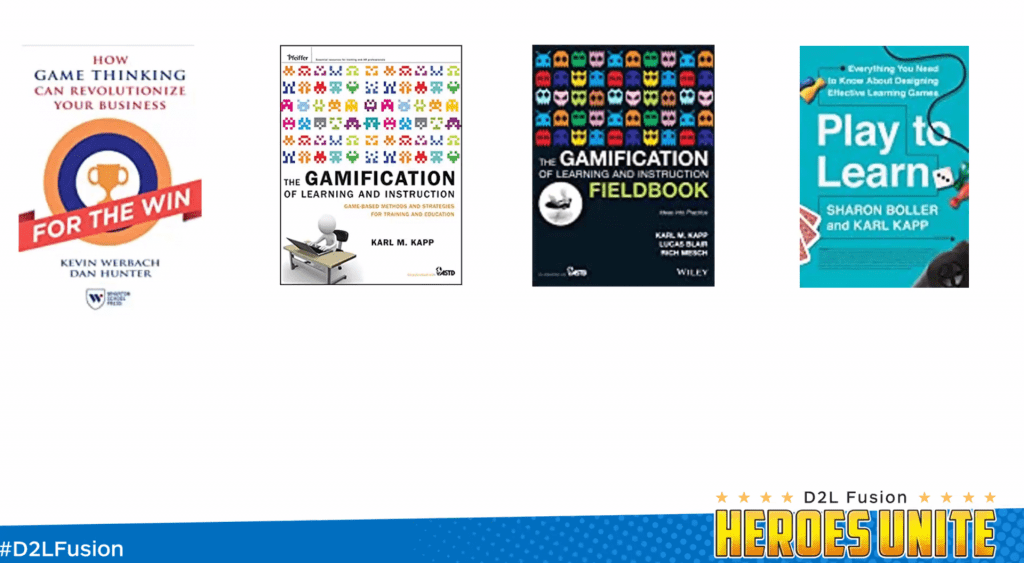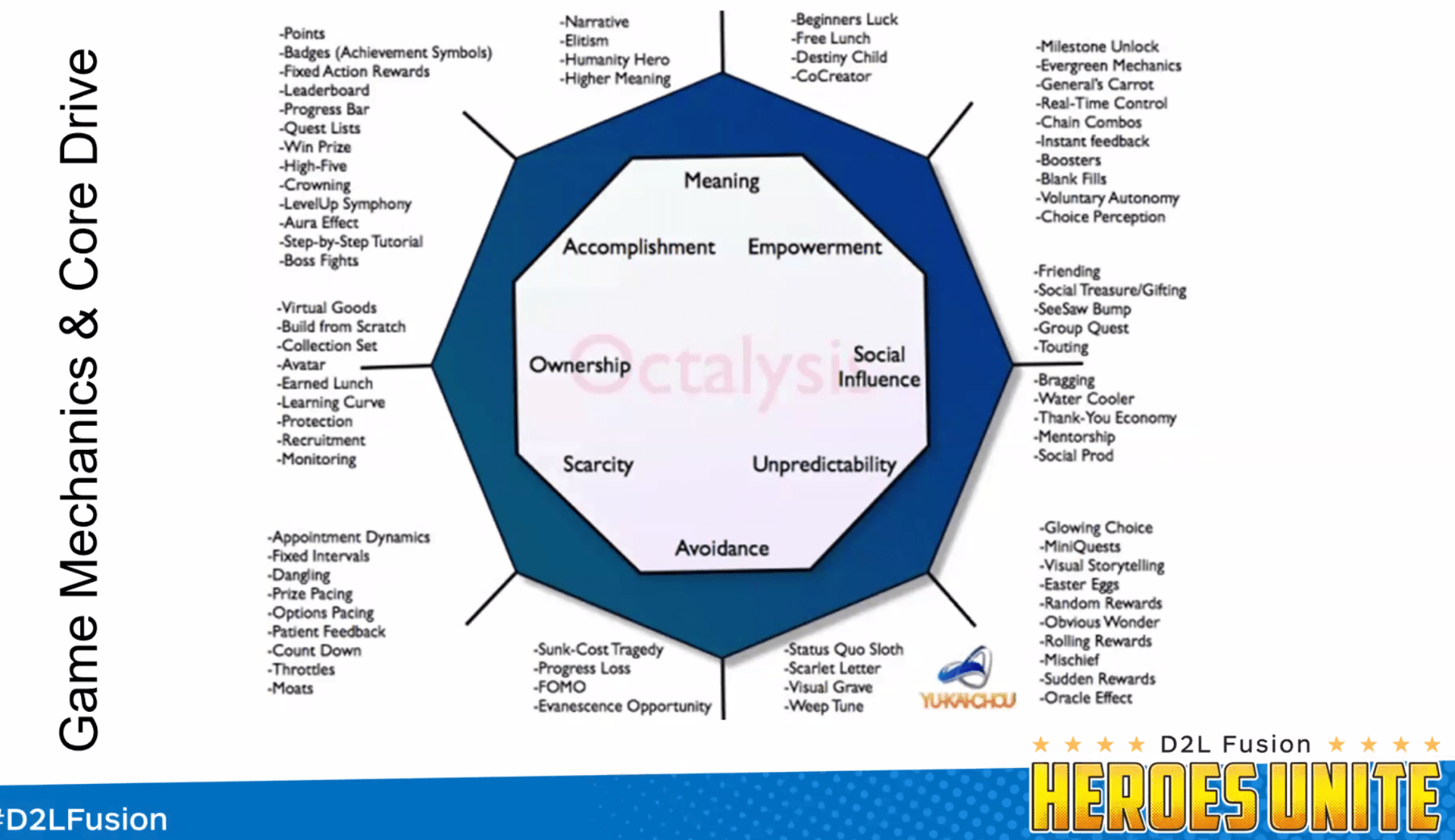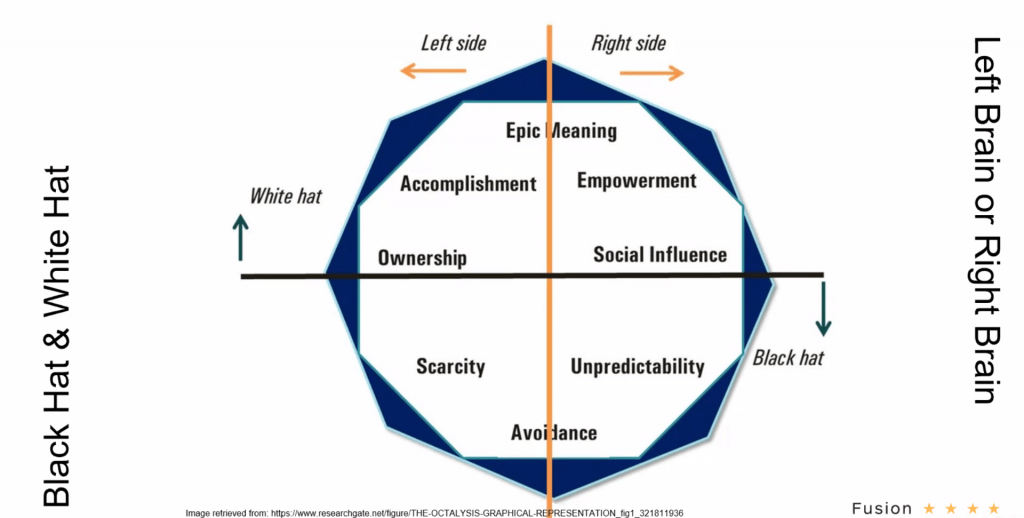Archive of ‘Library and information science’ category
Gamification Network: Exploring Gamification through the Octalysis Lens
Mary Nunaley
Karl Kapp The Gamification of Learning and Instruction
Kevin Werbach, Dan Hunter How Game Thinking Can Revolutionize Your Business
Yu-Kai Chou gamification design. Octalysis. https://www.gish.com/
8 core drives:
Meaning
Accomplishment
Empowerment
Ownership
Social Influence. social media, instagram influencers
Scarcity: scarcity with homework deadlines, coupons at the store
Unpredictability and curiosity. scavenger hunt in courses. careful when teaching.
Avoidance


The Octalysis Framework for Gamification & Behavioral Design
https://www.d2l.com/resources/webinars/
motivation

+++++++++++++++
https://yukaichou.com/octalysis-tool/
+++++++++++++++
https://island.octalysisprime.com/
+++++++++++++
https://yukaichou.com/
+++++++++++++
Lavender Dragon | Online Courses and Gamification
++++++++++++++
++++++++++++
more on gamification in this IMS blog
https://blog.stcloudstate.edu/ims?s=gamification
Everything you ever wanted to know about the history of Japan, but were afraid to ask
https://www.historyextra.com/period/modern/everything-you-wanted-know-about-history-japan-chris-harding-podcast/
https://play.acast.com/s/historyextra/everythingyoueverwantedtoknowaboutthehistoryofjapan-butwereafraidtoask
+++++++++++++
more on history in this IMS blog
https://blog.stcloudstate.edu/ims?s=history
An ‘ordinary’ Nazi
Historian Daniel Lee describes how the chance discovery of a cache of documents within a piece of furniture led him to uncover the life of Robert Griesinger, an ‘ordinary’ member of the SS.
https://www.historyextra.com/period/second-world-war/ordinary-nazi-life-ss-member-daniel-lee-podcast/
https://play.acast.com/s/historyextra/an-ordinary-nazi
+++++++++++++
more on history in this IMS blog
https://blog.stcloudstate.edu/ims?s=history
Revenue Per Minute for Big Tech [OC] from r/dataisbeautiful
https://www.facebook.com/groups/onlinelearningcollective/permalink/694538971176804/
I’m thinking of hosting a “Play with the Professor” game night using Agar.io and/or Skribbl.io.
Has anyone try that? How did it go? Any tips will be greatly appreciated.
++++++++++++++++++
more on gaming in this IMS blog
https://blog.stcloudstate.edu/ims?s=gaming
Podcast: The Link Between Academic Fraud and Cybersecurity Risk
https://campustechnology.com/articles/2020/10/23/podcast-the-link-between-academic-fraud-and-cybersecurity-risk.aspx
how essay mills operate and how academic fraud websites can lead to more serious cybersecurity threats. It’s a wild ride through falsified app reviews, shoddy workmanship and a rabbit hole of malicious activity.
+++++++++++++++
https://blog.stcloudstate.edu/ims?s=Academic+Fraud
more on academic fraud in this IMS blog
more on cybersecurity in this IMS blog
https://blog.stcloudstate.edu/ims?s=cybersecurity
WhatsApp now lets you post ephemeral messages that disappear after 7 days
Ephemerality has been one of the most radical and sticky features in messaging in years — it has now been around for close to a decade. And it has arguably been the defining feature for one of the runaway, viral hits of the genre, Snapchat — so much so that clones of the feature have popped up in a number of other apps, from those focused first and foremost on privacy like Signal and Telegram, through to those that are aimed at more casual consumer audiences, like WhatsApp today.
And there could be signs that Facebook is may be looking to roll this out in other apps in its stable, too. Earlier this year it tested disappearing messages in Instagram, which now works officially.
As with the storage changes, the new disappearing feature will not be switched on for users by default: you have to proactively change the settings.
+++++++++++++++++
more on Whatsapp in this IMS blog
https://blog.stcloudstate.edu/ims?s=whatsapp
https://www.techopedia.com/definition/25604/virtual-world
A virtual world is a computer-based online community environment that is designed and shared by individuals so that they can interact in a custom-built, simulated world. Users interact with each other in this simulated world using text-based, two-dimensional or three-dimensional graphical models called avatars. Avatars are graphically rendered using computer graphics imaging (CGI) or any other rendering technology. Individuals control their avatars using input devices like the keyboard, mouse and other specially designed command and simulation gadgets. Today’s virtual worlds are purpose-built for entertainment, social, ed
Girvan, C. (2018). What is a virtual world? Definition and classification.
Educational Technology Research and Development,
66(5), 1087–1100.
https://doi.org/10.1007/s11423-018-9577-y“definitions of virtual worlds lack an essential conceptualisation of what a virtual world is. The propensity towards a techno-centric definition has its advantages as it allows for a myriad of user experiences, however it results in confusion between technologies with similar technical features, most likely because a virtual world, much like a smart phone, relies on a combination of different technologies.
Shared, simulated spaces which are inhabited and shaped by their inhabitants who are represented as avatars. These avatars mediate our experience of this space as we move, interact with objects and interact with others, with whom we construct a shared understanding of the world at that time.”
https://www.yourdictionary.com/virtual-world
A 3D computer environment in which users are represented on screen as themselves or as made-up characters and interact in real time with other users. Massively multiuser online games (MMOGs) and worlds such as Second Life are examples. See MMOG, MMORPG, Second Life and metaverse.
++++++++++
more on virtual worlds in this IMS blog
https://blog.stcloudstate.edu/ims?s=virtual+worlds
https://cornellcollege.applicantpro.com/jobs/1568358.html
The Cornell College Center for the Literary Arts seeks a Distinguished Visiting Writer to teach a topics-based course in Writing Difference in a Digital World. Courses that engage race, citizenship, and/or identity through audio, video, or new media writing are especially welcome.
+++++++++++++
digital humanities in this IMS blog
https://blog.stcloudstate.edu/ims?s=digital+humanities
It’s 2020: Why Is The Internet Still Treated Like A Luxury, Not A Utility? from r/technology
It’s 2020: Why Is The Internet Still Treated Like A Luxury, Not A Utility?
https://gothamist.com/news/its-2020-why-is-the-internet-still-treated-like-a-luxury-not-a-utility
The city Board of Estimate first decided back in 1965 to slice up the city into cable-TV franchise fiefdoms, a setup that has survived largely intact in the internet era. Today, Altice (aka Optimum) has exclusive cable rights to the Bronx and southeast Brooklyn, while Charter (aka Spectrum, formerly Time Warner) has the rest of the city; Verizon FiOS is also available in a slowly expanding patchwork of areas overlying those two. As a result, most city residents have at most one other option if they’re unhappy with their current service, and many have none at all.
Americans weren’t always beholden to their local cable and phone companies for internet access, notes Christopher Mitchell, director of the Community Broadband Networks Initiative for the D.C.-based Institute for Local Self-Reliance. In the 1990s, thousands of internet service providers across the country offered dialup connections for relatively low prices, connecting via the copper wires of the phone system. The Telecommunications Act of 1996, he says, was initially designed to build on this by enabling multiple providers to use the new, faster networks that were then starting to be rolled out using higher-capacity coaxial and fiber-optic cable. It didn’t quite pan out.
“Both the Clinton and the Bush administrations dismantled that, under pressure from the big cable and telephone companies,” says Mitchell. “Most of those internet access providers went out of business, because they didn’t have access to the networks. If you have a policy that requires a company to pay $1,500 per home to get a subscriber, and it takes three to four years to earn that money back, you will not have much competition.”
The result has been a network of broadband services that are unaffordable or unavailable for a persistently high number of local households.
Torres noted that the city has spent nearly $300 million on renting otherwise-vacant hotels to house homeless New Yorkers during the pandemic, but hasn’t asked for the hotels to allow residents access to their broadband routers.
++++++++++++++
more on netneutrality in this IMS blog
https://blog.stcloudstate.edu/ims?s=netneutrality


